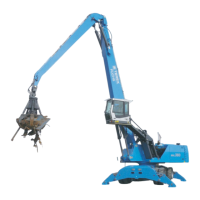WORK OPERATION 5
MHL380 D 5.21
5.3 Hoisting (optional)
5.3.1 General
Hoisting involves the lifting, transporting, and
lowering of loads with the aid of a fixing de-
vice (rope, chain, etc.), where personnel are
needed to assist with attaching and releasing
the load.
Loading machines MHL380 D are only to be
used for hoisting if the safety equipment pre-
scribed by national law is present and in full
working order.
h Chapter 2.2.10 Hoisting (optional)
5.3.2 Safety rules
Risk of fatal injuries from oscillating or fall-
ing loads as well as moving and tilting load-
Do not stand under suspended loads.
National provisions and accident prevention
regulations are to be observed.
The overload warning device is to be acti-
vated. Its display on the multifunction display
provides guidance on how the load to be
moved will affect the stability of the loading
machine.
The values of the carrying capacity table are
to be complied with. The carrying capacity
table is contained in these operating instruc-
tions.
A load hook should be used as hoisting
equipment. Its permitted carrying capacity
must be observed.
The loading machine is to stand on firm
ground and is to be evenly supported. n
Be
aware of risk of injury from moving outrigger!
The travel drive is to be blocked by the park-
ing brake and therefore secured against ac-
cidental operation.
Machine operators and personnel attaching
the loads must be instructed in the activity of
hoisting and authorized to do this.
Personnel attaching the loads must be clear-
ly visible (with high visibility vests), must be
wearing personal protective equipment and
may only be in areas directly visible to the
machine operator. The area of movement of
the personnel attaching the loads must be
free from obstructions and must allow se-
cure footing.
Prior to beginning work, the personnel at-
taching the loads are to be informed of the
range of movements and the risks of dan-
gers from the loading machine. Clear sig-
nals are to be agreed upon by the machine
operators and the personnel attaching the
loads. These signals are to be given to the
machine operator by only one of the attach-
ing personnel, appointed in advance by the
operator. Before the person attaching the
load gives a signal, all staff must leave the
danger zone and remain directly visible to
the machine operator.
Personnel attaching loads may only ap-
proach the loading equipment from the cab
side once they have the approval of the ma-
chine operator, because this side offers the
best visibility to the machine operator.
The machine operator should only grant his
approval if the loading equipment is station-
ary and in a favorable position for the per-
son attaching the load. The four-way control
levers may not be activated if the personnel
attaching the loads are in the danger zone.
Loads are to be attached in such a way that
they cannot slip or fall out. n
Do not use
damaged or inadequately dimensioned load-
bearing media (ropes, chains, etc.)! n
Al-
ways wear a helmet and protective goggles,
gloves, and boots when working with the
load-bearing media.
The machine operator must guide the load
slowly and as close to the ground as possi-
ble, while preventing it from swinging back
and forth. If necessary, the load must be se-
cured against swinging out.
Hoistin
g
(option

